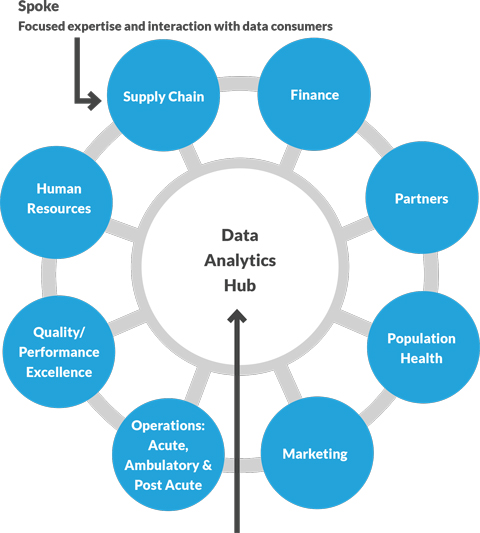Why healthcare organizations should consider implementing a data analytics center of excellence


Pam Arlotto (left) and Susan Irby
Traditional analytics structures tend to be either centralized or decentralized, each with advantages and drawbacks. A data analytics center of excellence represents a worthwhile hybrid approach.
Note: This article was updated for publication in the November issue of hfm.
In today’s healthcare landscape, data-driven insights are essential to strategic differentiation, financial performance and operational success. To glean those insights and to streamline the ownership and structural design of the data analytics function, healthcare leaders should consider implementing a data analytics center of excellence (CoE) and establishing the role of enterprise chief data officer (CDO).
These steps can eliminate the traditional command-and-control hierarchies and siloed decision-making processes that create a lack of trust and limit the development of analytics insights across the organization.
The healthcare data landscape
Many healthcare organizations are moving beyond traditional descriptive or diagnostic analytics to advanced analytics, which can lead to delivery of real-time insights, reinvention of jobs and work practices and disruption of healthcare business models.
Traditionally, healthcare data analytics structures have been entirely centralized or entirely decentralized, with analytics resources, tools and methods either residing with a central group or being embedded within various functions or departments across the organization.
Centralized and decentralized models each have strengths but also challenges, as illustrated in the exhibit below.
Centralized versus decentralized models for data analytics organizations
| Organization model | Pros | Cons |
| Decentralized: Teams and tools are embedded within business units and focus on departmental needs. |
|
|
| Centralized: All resources, tools and methods are managed and deployed by a central group. |
|
|
Source: Maestro Strategies. Used with permission.
Recent trends in data analytics structures
Today, the designation of data analytics structures as either centralized or decentralized has become less clear-cut due to various developments:
- Enterprise information systems have expanded through electronic health records and enterprise resource planning systems, along with a variety of tools requiring IT departments to support routine and ad hoc data analysis and reporting.
- Functional division leaders have deployed niche analytics systems in areas such as financial decision support, quality reporting, supply chain, human resources and marketing.
- New sources of data such as customer satisfaction, claims, social determinants of health, retail health and social media increasingly have become available.
- Interoperable data has expanded the breadth, depth and scope of data assets.
- Self-service capabilities increasingly have become necessary to support strategic, operational, financial and clinical decision-making.
- Data security and privacy have become top issues for most health systems.
The hybrid model: the CoE ‘hub-and-spoke’
A data analytics CoE, designed using a “hub-and-spoke” arrangement, provides a hybrid of the centralized and decentralized models and can incorporate the benefits of both while limiting the drawbacks of each.
The CoE model, as shown in the exhibit below, relies on a central hub that functions as a shared service and facilitator of data-driven insights for the organization. The hub clarifies the enterprise data strategy, supports data governance and ensures consistent use of tools, methods, standards and resources across the organization.
Center of excellence (hub-and-spoke) model for data analytics organizations

| Hub responsibilities |
| Architecture, tools and technology Manages data integration, architecture, development, maintenance, vendor management, etc. |
| Data stewardship Serves as primary advocate within the business to enable alignment of data definitions, data standards and data quality. |
| Advanced analytics Expands expertise beyond day-to-day analytics to include statistical analysis, modeling, data optimization, trending and data mining. |
| Culture and change management Communicates key capabilities, value of insight-driven decision-making and overall strategy. Supports “agile” decision-making and an iterative approach to analytics discovery, planning and continuous improvement. |
| Program management Ensures governance-delegated strategy is executed, prioritized initiatives are tracked and monitored, standards are established and followed, the voice of the customer is communicated and risk and value are balanced. |
| Data quality management Develops continuous data-improvement plans for all data sources, addressing data definition, integrity, timeliness and access through policies, processes, mitigation and reporting. |
| Coaching, training and customer support Educates data creators and customers regarding relevant analytics concepts, applications, tools and methods. Ensures each stakeholder has access to pertinent data sources and provides second-level support for analytics problems. |
Source: Maestro Strategies. Used with permission.
The spokes are vital because they are more focused and agile than the hub. Each spoke provides targeted, specific expertise to interact with and support the users of data analytics.
Examples of data analytics projects within spokes include:
- Financial decision support: Deploying cost-accounting programs
- Marketing: Analyzing targeted populations and geographies for growth
- Human resources: Studying employee retention and turnover patterns
- Population health managers: Stratifying risk and studying the impact of chronic conditions
- Service line leaders: Exploring clinical performance, operational efficiency and customer satisfaction
The table below defines the characteristics of the hub and the spokes.
Characteristics of the hub and spokes
| Hub characteristics | Spoke characteristics |
| Collaboration | Specialization |
| Global consistency | Unique characteristics |
| Cross-enterprise analytics content | Area-specific |
| Sharing of best practices | Agility |
| Consensus | Innovation |
| Enterprise data warehouse/”logical data warehouse” | Point systems |
| Landscape view | Focused view |
| Enterprise-level analytics | Departmental analytics |
| Analytics sandbox | Prototypes |
| Data scientist | “Citizen” roles |
Source: Maestro Strategies. Used with permission.
Leading the CoE: the role of the CDO
The transition from a centralized or decentralized data analytics structure to a hub-and-spoke model can be challenging. Many organizations designate a CDO to spearhead the change and to ensure that:
- A governance-delegated analytics strategy is executed
- Analytics structures and operating models are deployed at increasing maturity levels
- Standards are established and followed
- The voice of the customer is heard and communicated
- Agile decision-making is enabled
- Balance is achieved between risk and value
More specifically, the CDO should lead the following initiatives.
Assess enterprise data analytics maturity. The CDO should start by evaluating the effectiveness, consistency and capabilities of data analytics across the organization.
For centralized structures, ask functional decision-makers about their use of data:
- Do they trust reports and analytics results?
- Are the data outputs timely?
- Do analysts understand the business or clinical problem the decision-maker is trying to solve?
- Are the various options for scorecard development and advanced analytics understood?
For decentralized organization structures, ask decision-makers:
- Are tools, methods, expertise and data sources shared?
- Is there considerable rework from division to division?
- Does collaboration occur across the organization for complex projects?
- Does data analytics support enterprise strategic priorities?
Define a strategy for advanced data analytics. An effective data strategy should consider how the organization wants to use data; expand the organization’s capabilities in sourcing, combining and managing data; and transform the organization’s decision-making capacity through data-driven insights.
Launch demonstration projects or quick-win initiatives. Rather than rushing to build a CoE, start with a few quick wins. For example:
- Engage decision-makers from decentralized functions with a problem to solve.
- Collaborate with analysts and subject-matter experts.
- Define key hypotheses, data sources and analytics tools.
- Develop an initial prototype.
- Generate insights and a plan to operationalize them.
- Communicate the lessons learned and identify future quick-win initiatives.
Over time, as these initiatives gain traction, the CoE can be formed.
Develop the hub-and-spoke operating model. This step entails establishing the roles and responsibilities of both the hub and the spokes, developing a roster of domain experts, acquiring talent that might not exist in the organization today (e.g., experts in data mining, statistical analysis, modeling and data optimization) and communicating the key capabilities of the CoE to the organization.
Education programs for data creators, analysts and users regarding relevant analytics concepts, applications, tools and methods should be developed and deployed across the enterprise.
Plan for data quality. Alignment of data definitions, standards and quality can be attained by identifying information sources and ensuring consistency, completeness, validity and timeliness.
For all data sources, the CoE should develop continuous data-improvement plans that describe the following data processes and protocols:
- Creation (i.e., inputs into source systems)
- Curation
- Integrity
- Timeliness
- Access rights
- Security
- Protection and preservation
The CDO should catalogue enterprise performance metrics and key enterprise scorecards and develop plans to streamline and harmonize data processes and ultimately to move to self-service.
The potential for transformational benefits using a CoE
Success with a CoE that incorporates a hub-and-spoke model for data analytics will depend on thoughtful consideration of the unique characteristics of an organization. By leveraging and unlocking the value of enterprise information assets, a data analytics CoE will generate an insights-driven decision-making culture, enhance advanced analytics effectiveness and drive transformational change.





